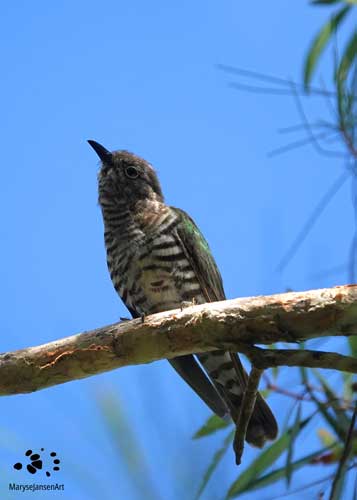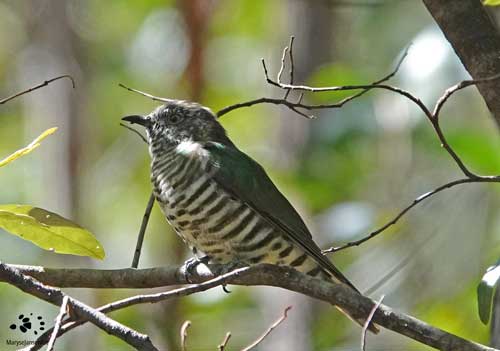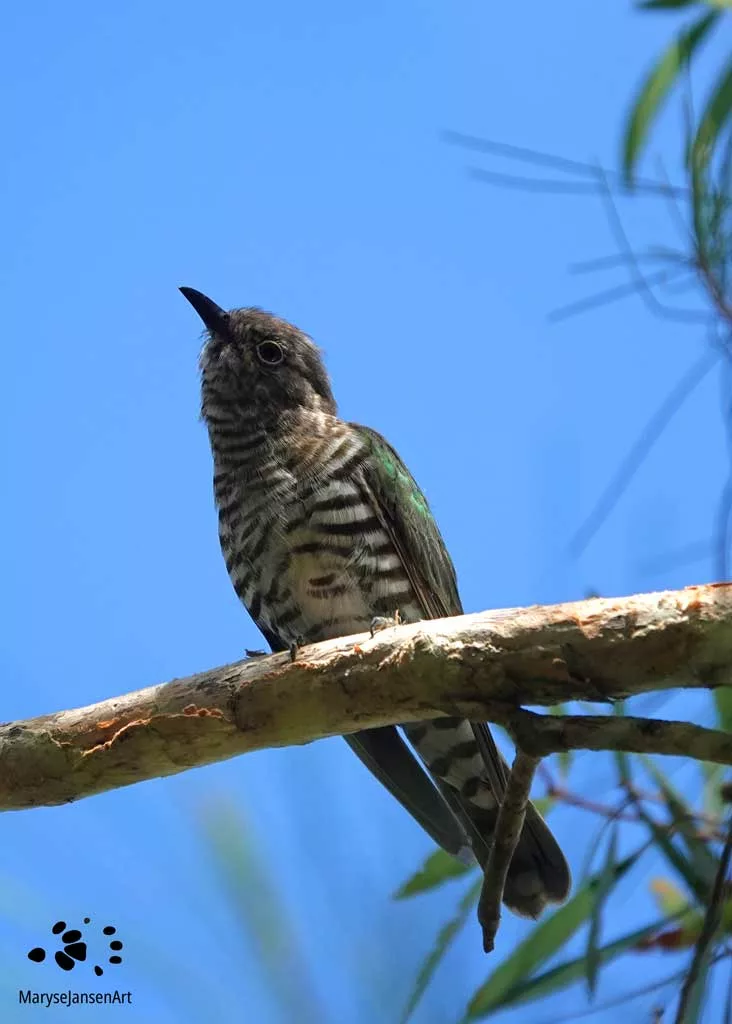Bird Photography with marysejansenart
This bird practices lazy parenting in beautiful locations

Table of Contents
Shining Bronze-Cuckoo a pleasure for the eye!
A small bird grabs my attention. It is not easy to spot as it moves around in the foliage of the trees but every now and then I get a glimpse of a beautiful metallic green shine that has me interested. This shiny colour is visible on the birds back and wings. The underparts are barred with heavily contrasting white and dark green colours. I peer patiently through the lens of my camera, waiting for the right moment to get a clean shot. Yes, there it is! This little beauty is a Shining Bronze-Cuckoo!
The top of its head and neck are also metallic, but more a bronze colour compared to the green wings. The beak and feet are black and the feet have yellow undersides.
When I see the species next, I first don’t realise what it is. A bird flies past me with a purple metallic head, something which I have never seen before! It turns out to be a female Shining Bronze-Cuckoo! Females look very similar to males but they may indeed have a more purplish sheen on their head and neck as well as more bronze-tinged barring on their bellies. Male or female, these birds are a real pleasure for the eye!

Parasitic nesting habits
The Gerygones, another type of small bird, might be less excited about the Shining Bronze-Cuckoos. They are cuckoos after all, and thus they parasite on other species’ nests, specifically the nests of the little Gerygones. They may also choose nests from Fairy-wrens or Thornbills.
I encounter a Brown Thornbill in close proximity to where I just spotted the Shining Bronze-cuckoo. You can see it in the video below. As I am taking photographs as well as videos during my walks you can imagine it is not always possible to get both. Birds, especially small birds like these, tend to be quite restless and often have moved out of sight before I can even get a good photo or some footage, let alone both! This time, I am pleased with my footage but unfortunately I don’t get a chance to get a photo as well.
Back to the cuckoo. The female Shining Bronze-Cuckoo seeks out a nest from one of these other small birds. Then she removes an egg and lays one of her own eggs instead. The colour of the cuckoo’s egg is a lot darker then that of the host eggs. It has been found that the host birds tend to accept the eggs, regardless of their different colour. Other cuckoos however, will remove brighter coloured eggs, so the darker colour protects the egg from being removed by another cuckoo. This might simply be because in the dark dome-shaped nests they cannot easily see the darker egg.
It takes about 15 days for the egg to hatch. Once the egg hatches, the cuckoo chick ejects the host chicks from the nest. About 3 weeks later the cuckoo chick will fledge and another 16-19 days later it will be completely independent from its host parents. While the host parents work hard to feed and raise these chicks, the Shining Bronze-Cuckoo has adopted a ‘lazy parenting’ style!
How to eat a toxic hairy caterpillar!
The birds are insectivorous and eat insects that are often avoided by other birds because they are toxic, such as hairy caterpillars and ladybirds. To understand how the bird deals with the hairs or spines on these caterpillars we need to understand a little bit of bird anatomy.
Let’s have a look at the bird’s stomach. All birds have two parts to their stomach. The first part resembles what the human stomach does. But the second part, the gizzard, is where the magic happens. The gizzard is very thick and muscular, especially in birds that eat hard items, such as seeds and nuts or whole prey including bones.
These birds will often pick up grit which collects in the gizzard. These little grains of sand, rock or shell, moved around by the strong muscle, help grind the hard food items. After the digestible parts have been moved on into the intestines, the gizzard contracts so that the bird can cough up the non-digestible bits.
The gizzard of the Shining-bronze Cuckoo is lined with a soft, thick lining. The spines on the caterpillar get caught in there for the bird to spit them out later!
Living the good life
At the start of autumn, this might be the last time I see a Shining Bronze-Cuckoo for a while. The birds are only summer visitors here in Eastern Australia, and also in Western Australia. They winter in places like the Lessa Sunda Islands of Indonesia; New Guinea and the Solomon Islands. Not a bad way to spend your life between beautiful forests in Australia and stunning tropical islands!
Join me on my latest walk in the bush and get a glimpse of the Shining Bronze-Cuckoo and also of one of its host birds, the Brown Thornbill in a new episode of ‘Come for a walk in the Australian Bush’:
If you are interested in purchasing a print of ‘Shining Bronze-Cuckoo’ or would like to see what the image looks like on the various merchandise products, please head to my shop.


